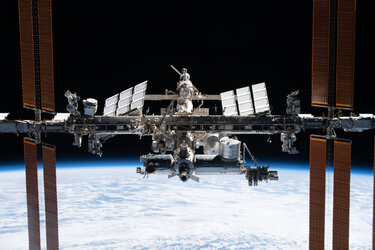N° 44–2024: Media invitation: Sentinel-2C pre-launch media briefings
27 August 2024
The latest satellite in Europe's Copernicus programme, Sentinel-2C, is set for launch on the last Vega rocket lift off from Europe's Spaceport in French Guiana, on 3 September 2024 at 22:50 local time (4 September 03:50 CEST).
Journalists are invited to learn more about the last flight of Europe’s Vega launch (known as VV24), carrying satellite Sentinel-2C, by joining a pre-launch media briefing in English, followed by question-and-answer sessions in French, German, Italian and Spanish. All events will be held online and take place on 29 August.
The Copernicus Sentinel-2 mission provides high-resolution optical imagery for a wide range of applications including land, water and atmospheric monitoring. The mission is based on a constellation of two identical satellites flying in the same orbit but 180° apart: Sentinel-2A and Sentinel-2B. Together, they cover all of Earth’s land and coastal waters every five days.
Sentinel-2C will be flown by expert teams at ESA’s ESOC mission control centre, Darmstadt, Germany and will continue the legacy of its predecessors delivering high-resolution data that is essential to Copernicus – the Earth observation component of the EU Space Programme.
Vega was the very first rocket development programme entirely managed by ESA, built to send small satellites into low Earth orbit. Designed by Avio, who is also the prime contractor, the rocket is operated by Arianespace. Vega consists of four stages, the first three propelled by solid propellant motors and the last stage uses liquid propulsion.
Vega’s inaugural flight took place in February 2012 and since then, it has taken more than 100 missions to space from dozens of European institutions but also customers around the world. The Sentinel-2A and Sentinel-2B satellites were also launched on Vega.
This final launch marks the handover of Vega to the upgraded Vega-C. Vega has for years ensured that Europe has a versatile, independent access to space, complementing the Ariane family of rockets to launch any satellite to any orbit – continuing with Vega-C and Ariane 6.
The programme below highlights the different media activities planned ahead of launch and their respective registration process.
Please note that journalists wishing to attend several of the events mentioned below should register for each activity separately to ensure that they receive the right link/information for each event.
Press briefing per language
Thursday 29 August, 10:30-11:30 CEST: online media briefing in English
Participants:
- Simonetta Cheli, Director of Earth Observation Programmes, ESA
- Toni Tolker-Nielsen, Director of Space Transportation, ESA
- Stéphane Israël, CEO, Arianespace
- Mauro Facchini, Head of Unit for Earth Observation, European Commission
Thursday 29 August,11:30-12:15 CEST: online question and answer session in French
Participants:
- Toni Tolker-Nielsen, Director of Space Transportation, ESA
- Stéphane Israël, CEO, Arianespace
- Mauro Facchini, Head of Unit for Earth Observation, European Commission
- Constantin Mavrocordatos, Project Manager of Sentinel-2 Project, ESA
Thursday 29 August,11:30-12:15 CEST: online question and answer session in German
Participants:
- Claudia Flöte, COO, Arianespace
- Robert Meisner, Directorate of Earth Observation Programmes, ESA
- Albert Zaglauer, Head of Earth Observation Systems, Airbus Defence and Space
Thursday 29 August,11:30-12:15 CEST: online question and answer session in Italian
Participants:
- Simonetta Cheli, Director of Earth Observation Programmes, ESA
- Stefano Bianchi, Head of Flight Programmes, ESA
- Fabrizio Fabiani, Vega Program Director, Arianespace
- Gabriele Mazzoni, Head of Launch Vehicle Production Programs, Avio
Thursday 29 August,11:30-12:15 CEST: online question and answer session in Spanish
Participants:
- Ferran Gascon, Sentinel-2 Mission Manager, ESA
- Oriol Alvarez Trotta, Copernicus LSTM Project Manager, Airbus
Registration:
Please express interest for any of the above events by Thursday 29 August at 09:00 CEST by selecting and completing the relevant form at
https://blogs.esa.int/forms/ninja-forms/4oqw8
ESA Web TV
The English pre-launch press briefings will be streamed via ESA Web TV.
Contacts
ESA: media@esa.int
Arianespace: d.joseph-gabriel@arianespace.com
European Commission : DEFIS-PRESS@ec.europa.eu
Further information
More information about Sentinel-2:
https://www.esa.int/Applications/Observing_the_Earth/Copernicus/Sentinel-2
More information about Vega:
https://www.esa.int/Enabling_Support/Space_Transportation/Vega
More information about ESA:
Images
https://www.esa.int/ESA_Multimedia/Missions/Sentinel-2/(result_type)/images
Vega image gallery
https://www.esa.int/ESA_Multimedia/Missions/Vega/(result_type)/images
Terms and conditions for using ESA images:
www.esa.int/spaceinimages/ESA_Multimedia/Copyright_Notice_Images
For questions or more information related to ESA images, please contact directly spaceinimages@esa.int
Videos
https://www.esa.int/ESA_Multimedia/Missions/Sentinel-2/(result_type)/videos
https://www.esa.int/ESA_Multimedia/Missions/Vega/(result_type)/videos
https://www.esa.int/ESA_Multimedia/Videos
https://www.esa.int/esatv/Videos_for_Professionals
Terms and conditions for using ESA videos:
https://www.esa.int/spaceinvideos/Terms_and_Conditions
For questions or more information related to ESA videos, please contact directly spaceinvideos@esa.int
Social media
Follow ESA on:
X: @esa @ESA_EO @ESA_transport
Instagram: Europeanspaceagency , @ESA_Earth
Facebook: EuropeanSpaceAgency
YouTube: ESA
LinkedIn: European Space Agency - ESA
Pinterest: European Space Agency - ESA
About the European Space Agency
ESA is an intergovernmental organisation, created in 1975, with the mission to shape the development of Europe’s space capability and ensure that investment in space delivers benefits to the citizens of Europe and the world.
ESA has 22 Member States: Austria, Belgium, the Czech Republic, Denmark, Estonia, Finland, France, Germany, Greece, Hungary, Ireland, Italy, Luxembourg, the Netherlands, Norway, Poland, Portugal, Romania, Spain, Sweden, Switzerland and the United Kingdom. Latvia, Lithuania, Slovakia and Slovenia are Associate Members.
ESA has established formal cooperation with four Member States of the EU. Canada takes part in some ESA programmes under a Cooperation Agreement.
By coordinating the financial and intellectual resources of its members, ESA can undertake programmes and activities far beyond the scope of any single European country. It is working in particular with the EU on implementing the Galileo and Copernicus programmes as well as with Eumetsat for the development of meteorological missions.
Learn more about ESA at www.esa.int















 Germany
Germany
 Austria
Austria
 Belgium
Belgium
 Denmark
Denmark
 Spain
Spain
 Estonia
Estonia
 Finland
Finland
 France
France
 Greece
Greece
 Hungary
Hungary
 Ireland
Ireland
 Italy
Italy
 Luxembourg
Luxembourg
 Norway
Norway
 The Netherlands
The Netherlands
 Poland
Poland
 Portugal
Portugal
 Czechia
Czechia
 Romania
Romania
 United Kingdom
United Kingdom
 Slovenia
Slovenia
 Sweden
Sweden
 Switzerland
Switzerland


























